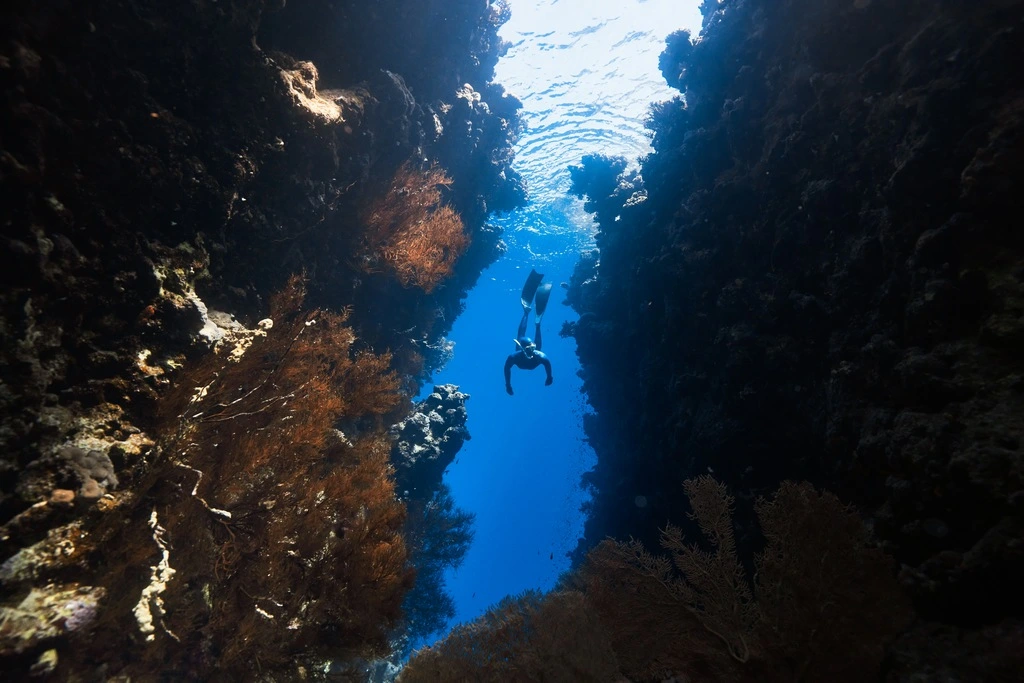My husband and I have been passionate scuba divers for over two decades. We’ve explored reefs and wrecks all over the world, but since moving to Thailand in 2019, we’ve been spoiled with some of the best scuba diving in Thailand. The underwater adventures here aren’t the best in the world, but they’re pretty awesome and can still blow you away.
In this article, I’ll share why Thailand is an amazing diving destination and why 2025 is the perfect year to plan your trip. Also, I’ll show you the top dive spots you can’t miss.
Whether you’re a seasoned diver or just starting out, you’ll find everything you need to know to plan an unforgettable scuba experience. Let’s dive in! (hehe)
Why Scuba Dive in Thailand?
Thailand is pretty incredible for scuba divers. Here’s why you should pack your fins and head to the Land of Smiles:
Warm Waters and Year-Round Diving
Thailand’s waters are warm all year, with temperatures usually between 27°C to 30°C (80°F to 86°F). That means no freezing wetsuits or chattering teeth—just comfortable dives, no matter the season. You can plan a dive trip anytime, but certain regions shine at specific times of the year (more on that later!).
Perfect for Beginners and Pros
If you’re just getting started, Thailand has plenty of calm, shallow sites with easy conditions. For advanced divers, there are deeper pinnacles, thrilling drift dives, and fascinating wrecks to explore. Dive schools and operators are everywhere, so you’ll have no trouble finding a course or a guide that fits your level.
Incredible Marine Life
Thailand’s underwater world is buzzing with life. You might spot a majestic whale shark or a graceful manta ray gliding by. Coral reefs are alive with colorful fish, sea turtles, and quirky creatures like seahorses and nudibranchs.
Great Dive Conditions
Visibility is usually excellent, ranging from 33 to 100 feet (10 to 30 meters), depending on the location and time of year. Currents vary, too, so you can choose gentle sites for relaxed dives or stronger currents for a more adventurous experience. Seasonal weather shifts between the Andaman Sea and the Gulf of Thailand, so there’s always a great spot to dive if you time it right.

Top Dive Destinations in Thailand
Here’s a table summarizing the top dive sites, and below, you’ll find detailed information about each one.
1. Similan Islands
The Similan Islands are a must-visit for any serious diver. Located in the Andaman Sea, this group of islands is famous for its clear waters, dramatic underwater rock formations, and an incredible variety of marine life.
- What to Expect:
You’ll find swim-throughs, colorful coral gardens, and stunning granite boulders creating unique underwater landscapes. This is where the magic happens for advanced divers. - Best Dive Sites:
- Elephant Head Rock: Known for its massive boulders, arches, and caves, this site offers a thrilling experience with plenty of spots to explore. Keep an eye out for reef sharks and schools of snapper.
- Richelieu Rock: One of the best dive sites in Thailand, Richelieu Rock is a magnet for marine life. It’s famous for whale shark sightings, vibrant soft corals, and tiny critters like seahorses and ghost pipefish.
- Who It’s For:
The Similan Islands are perfect for advanced divers who want to challenge themselves. The currents can be strong, so some experience is recommended (but I’ve also seen plenty of beginners diving here safely). - How to Get There:
The easiest way to reach the Similan Islands is by starting from Khao Lak, a coastal town in southern Thailand. From there, speedboats and liveaboards regularly depart to the islands. The journey takes about 1.5 to 2 hours by speedboat. If you’re coming from Phuket, expect a slightly longer trip, as you’ll first need to drive or take a bus to Khao Lak (approximately 1.5 hours) before hopping on a boat.
We did a liveaboard trip to the Similans in 2015. It was a 3-day trip with 4 dives each day. Incredible and exhausting! - Season:
Plan ahead because the Similan Islands are part of a protected national park and are only open for diving from mid-October to mid-May.
2. Surin Islands
The Surin Islands are a fantastic spot for both divers and snorkelers. Located in the Andaman Sea near the Thai-Myanmar border, these islands are home to vibrant coral reefs and a wide range of marine life.
- What to Expect:
You’ll find colorful corals and plenty of fish, from tiny reef fish to larger creatures like sea turtles. - Who It’s For:
The Surin Islands are great for all experience levels. Beginners will appreciate the calm waters, and experienced divers will enjoy the variety of marine life. Snorkelers will also find plenty to see just below the surface. - How to Get There:
Most trips to the Surin Islands start from Kuraburi Pier, which is about 1.5 hours by car from Khao Lak. From there, you can take a speedboat, which takes around 1.5 hours. Many liveaboard trips include the Surin Islands in their routes. - Season:
The Surin Islands are open for diving from mid-October to mid-May, offering a quieter alternative to some of Thailand’s busier dive destinations. If you’re looking for a spot to enjoy marine life away from the crowds, this is it!
3. Koh Tao
Koh Tao, also known as “Turtle Island,” is one of the most popular places to dive in Thailand. We lived there for a total of six months and absolutely loved it (even though it’s pretty crowded with tourists year-round). Known for its calm waters and easy dive conditions, it’s a favorite spot for beginners, but it also offers exciting dives for more experienced adventurers.
- What to Expect:
Koh Tao is THE hub for dive schools in Thailand. The shallow reefs are full of colorful marine life, including parrotfish, butterflyfish, and many black tip sharks. For seasoned divers, there are deeper sites with more challenging conditions and larger marine life. - Key Dive Sites:
- Chumphon Pinnacle: This deeper site is great for spotting barracudas, giant groupers, and sometimes even whale sharks (my husband was lucky once).
- Sail Rock: Located between Koh Tao and Koh Phangan, Sail Rock is famous for its vertical “chimney” swim-through and large schools of fish. It’s one of the best dive sites in the Gulf of Thailand and also accessible from Koh Phangan.
- Who It’s For:
Koh Tao is perfect for beginners who want to start their diving journey, but it also has something for experienced divers looking to explore deeper sites. - How to Get There:
Koh Tao is accessible by ferry from Koh Samui, Koh Phangan, or the mainland at Surat Thani or Chumphon. Ferries take around 1.5 to 2.5 hours, depending on the starting point. Many travelers combine a visit to Koh Tao with nearby islands of Koh Phangan and Koh Samui for a complete Gulf of Thailand experience.
4. Phuket
Phuket is a popular diving hub in Thailand, offering a mix of wreck dives, coral reefs, and drift diving experiences. It’s an excellent choice for divers of all levels, with easy access to some of the Andaman Sea’s best underwater spots.
- What to Expect:
Phuket’s dive sites are diverse, ranging from shallow reefs ideal for beginners to deeper wrecks and drift dives for experienced divers. The waters here are full of marine life, including leopard sharks, moray eels, and vibrant schools of fish. - Key Dive Sites:
- King Cruiser Wreck: This former ferry, which sank in 1997, is now a thriving artificial reef. It’s home to colorful soft corals and large schools of fish.
- Shark Point: Known for its healthy coral formations and frequent leopard shark sightings, this dive site is perfect for those looking to combine marine life with exciting drift dives.
- Who It’s For:
Phuket’s dive spots cater to everyone. Beginners can enjoy reef dives closer to shore, while advanced divers can explore deeper wrecks and drift sites with stronger currents. - How to Get There:
Phuket is well-connected, with direct flights from many countries. Most dive trips depart from Chalong Bay on Phuket’s southeastern coast. Options include day trips to nearby sites or liveaboards that venture to farther locations like the Similan Islands.
Check out my review of our favorite hotel in Phuket.
5. Koh Phi Phi
Koh Phi Phi is not just famous for its stunning beaches; it’s also a fantastic spot for scuba diving. The island offers dramatic underwater landscapes, including caves, swim-throughs, and coral-covered walls.
- What to Expect:
The diving around Koh Phi Phi is exciting, with unique underwater topography and plenty of marine life. You might see blacktip reef sharks, turtles, and a variety of tropical fish darting around vibrant coral formations. - Key Dive Sites:
- Bida Nok: This site is known for its impressive walls, swim-throughs, and the chance to spot reef sharks cruising along the drop-offs.
- Bida Nai: Located near Bida Nok, this site features shallower reefs, caves, and lots of colorful marine life.
- Who It’s For:
Koh Phi Phi has something for everyone. Beginners can explore shallower reefs, while more experienced divers can enjoy the deeper walls and challenging swim-throughs. - How to Get There:
To reach Koh Phi Phi, take a ferry from Phuket or Krabi, which takes around 1.5 to 2 hours. Once you’re on the island, dive shops are easy to find, and trips to nearby dive sites are quick and convenient.
6. Koh Lanta
Koh Lanta is a laid-back diving destination in the Andaman Sea, known for its relaxed vibe and incredible proximity to world-class dive sites like Hin Daeng and Hin Muang. It’s a great choice for divers looking to escape the crowds and experience some of Thailand’s best underwater adventures.
- What to Expect:
The waters around Koh Lanta are full of marine life, from vibrant reef fish to larger pelagics. Hin Daeng and Hin Muang are famous for their steep drop-offs, colorful coral walls, and the chance to spot majestic manta rays. Whale sharks also occasionally visit these waters. - Key Dive Sites:
- Hin Daeng: Known as “Red Rock,” this site is a top spot for manta ray encounters. The deep walls and strong currents make it ideal for advanced divers.
- Hin Muang: “Purple Rock” offers another thrilling dive, with soft corals in shades of purple and an abundance of marine life, including barracudas, jacks, and rays.
- Who It’s For:
Koh Lanta is perfect for those seeking a quieter diving experience. Beginners can enjoy the calmer reefs closer to shore, while advanced divers will appreciate the deeper, more challenging sites like Hin Daeng and Hin Muang. - How to Get There:
Koh Lanta can be reached by ferry from Krabi, Phuket, or Koh Phi Phi. Once on the island, dive operators offer day trips and liveaboard options to the nearby dive sites. The journey to Hin Daeng and Hin Muang typically takes 1.5 to 2 hours by boat.
7. Pattaya
Pattaya might not be the first place you think of for scuba diving, but it’s a great choice if you’re into wreck diving or looking for a convenient spot near Bangkok.
- What to Expect:
Pattaya’s dive sites are best known for their wrecks, which attract a variety of marine life. The waters here are home to barracudas, groupers, and the occasional ray, making it an interesting mix for underwater exploration. - Key Dive Sites:
- HTMS Khram Wreck: This sunken warship is a popular dive site, teeming with marine life and offering great opportunities for wreck penetration.
- HTMS Kut Wreck: Another ex-naval ship, this site is slightly deeper and perfect for advanced divers.
- Who It’s For:
Pattaya is ideal for divers who love wreck exploration. The sites are beginner-friendly at shallower depths, but more experienced divers will enjoy the technical challenges of wreck penetration and deeper dives. - How to Get There:
Pattaya is just a two-hour drive from Bangkok, making it one of the most accessible dive destinations in Thailand. Dive shops in Pattaya run regular trips to the nearby wrecks, so you can easily plan a day or weekend of diving.
Where to Stay in Bangkok
Check out these amazing Hotels in Bangkok or use the map below. 👇
Diving Seasons and Best Times to Visit
Thailand offers year-round diving, but the best conditions depend on the region and the season. Here’s a breakdown to help you plan your trip.
- Andaman Sea (November to April):
This is the best time to dive in the Andaman Sea, which includes top spots like the Similan Islands, Surin Islands, Koh Phi Phi, and Koh Lanta. The dry season brings calm seas, great visibility, and comfortable water temperatures. Whale sharks and manta rays are often spotted during this time, making it a prime season for marine life enthusiasts. - Gulf of Thailand (May to September):
For sites like Koh Tao, Koh Samui, and Sail Rock, the Gulf of Thailand shines during its dry season. Waters are clear, visibility is excellent, and conditions are calm. The weather is ideal for exploring the Gulf’s vibrant reefs and iconic dive spots.
Monsoon Patterns and Their Impact
Thailand’s monsoons affect diving conditions depending on the region:
- Andaman Sea: Monsoons hit from May to October, bringing rough seas, reduced visibility, and limited access to many dive sites.
- Gulf of Thailand: Monsoons occur from October to April, but conditions are typically better than in the Andaman Sea during its monsoon.
Best Times for Specific Regions
- If your trip is between November and April, head to the Andaman Sea for the best visibility and marine life encounters.
- If you’re traveling between May and September, focus on the Gulf of Thailand for its calm conditions and sunny days.
Unique Marine Encounters in Thailand
Whale Shark Sightings
- When to Spot Them: Whale sharks usually appear between February and May.
- Where to Spot Them: Divers often see them at Richelieu Rock in the Andaman Sea and Chumphon Pinnacle in the Gulf of Thailand.
Manta Ray Encounters
- When to Spot Them: The best time to see manta rays is from November to April.
- Where to Spot Them: You can find them at Hin Daeng and Hin Muang near Koh Lanta.
Macro Diving Highlights
- Nudibranchs: These colorful creatures show up at many sites, including Richelieu Rock and Koh Tao.
- Seahorses: You can spot them at muck diving sites around Phuket and Koh Lanta, often clinging to soft corals or hiding in sandy areas.
- Other Critters: Ghost pipefish, frogfish, and cuttlefish appear frequently at Richelieu Rock and Koh Tao.
👉 You might also find these articles interesting:
– When is the Cheapest Time to Fly to Thailand?
– 35 Interesting Facts About Thailand
– The 8 Best Airlines to Fly to Thailand
– Thailand in Winter: What to Expect
Diving Tips for Thailand
Certification Requirements and Tips for Beginners
- Thailand is a great place to start diving. Many dive centers offer affordable PADI Open Water Certification courses.
- Beginners should start with calm sites like Koh Tao or shallow reefs near Phuket.
- Always dive within your limits and follow your instructor’s guidance.
Eco-Friendly Diving Practices
- Avoid touching coral or marine life to prevent damage.
- Use reef-safe sunscreen to protect marine ecosystems.
- Don’t take any souvenirs from the ocean, like shells or coral.
- Choose dive operators that prioritize sustainability and marine conservation. Look for certifications like PADI Green Star, 100% AWARE Partner, or affiliation with environmental groups like Reef-World Foundation or Green Fins.
Packing Essentials for a Diving Trip
- Certification card and logbook (we only carry it digitally).
- Personal dive gear if you have it (mask, snorkel, fins).
- Reef-safe sunscreen to protect yourself and marine life.
- Quick-dry towels and swimwear.
- A dry bag to keep your belongings safe and dry on boat trips.
- Motion sickness tablets for long boat rides (the yellow ones for 10 THB in Thai pharmacies).
- Optional extras: A dive computer or underwater camera to enhance your experience.
Final Thoughts on the Best Scuba Diving in Thailand
Thailand isn’t the ultimate diver’s paradise, but it has some truly amazing spots if you know where to look. Places like Richelieu Rock, Hin Daeng, and Sail Rock offer unforgettable underwater adventures, from whale shark encounters to vibrant coral reefs.
Whether you’re a beginner or an experienced diver, Thailand’s waters have something special for everyone.
If you’re diving in 2025, I hope this guide helps you make the most of your trip. Let me know what you see out there—I’d love to hear your stories!
Thank you for reading and for making me part of your day! Yours, Lulu
Just a heads up: some links in the article “The Best Scuba Diving in Thailand” on Nomadmum.com are affiliate links. This means if you click and buy, I might earn a small commission at no extra cost to you.






